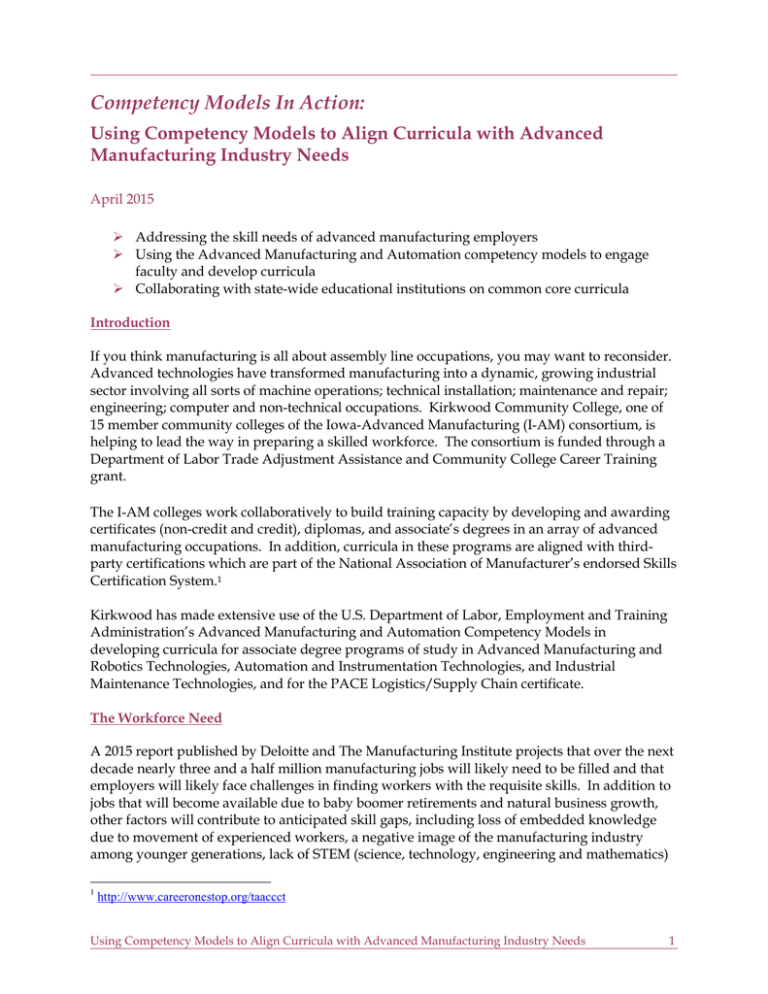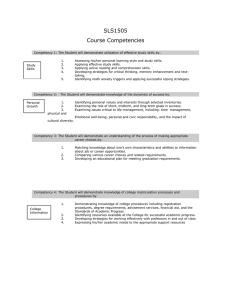Using Competency Models to Align Curricula with
advertisement

Competency Models In Action: Using Competency Models to Align Curricula with Advanced Manufacturing Industry Needs April 2015 Addressing the skill needs of advanced manufacturing employers Using the Advanced Manufacturing and Automation competency models to engage faculty and develop curricula Collaborating with state-wide educational institutions on common core curricula Introduction If you think manufacturing is all about assembly line occupations, you may want to reconsider. Advanced technologies have transformed manufacturing into a dynamic, growing industrial sector involving all sorts of machine operations; technical installation; maintenance and repair; engineering; computer and non-technical occupations. Kirkwood Community College, one of 15 member community colleges of the Iowa-Advanced Manufacturing (I-AM) consortium, is helping to lead the way in preparing a skilled workforce. The consortium is funded through a Department of Labor Trade Adjustment Assistance and Community College Career Training grant. The I-AM colleges work collaboratively to build training capacity by developing and awarding certificates (non-credit and credit), diplomas, and associate’s degrees in an array of advanced manufacturing occupations. In addition, curricula in these programs are aligned with thirdparty certifications which are part of the National Association of Manufacturer’s endorsed Skills Certification System.1 Kirkwood has made extensive use of the U.S. Department of Labor, Employment and Training Administration’s Advanced Manufacturing and Automation Competency Models in developing curricula for associate degree programs of study in Advanced Manufacturing and Robotics Technologies, Automation and Instrumentation Technologies, and Industrial Maintenance Technologies, and for the PACE Logistics/Supply Chain certificate. The Workforce Need A 2015 report published by Deloitte and The Manufacturing Institute projects that over the next decade nearly three and a half million manufacturing jobs will likely need to be filled and that employers will likely face challenges in finding workers with the requisite skills. In addition to jobs that will become available due to baby boomer retirements and natural business growth, other factors will contribute to anticipated skill gaps, including loss of embedded knowledge due to movement of experienced workers, a negative image of the manufacturing industry among younger generations, lack of STEM (science, technology, engineering and mathematics) 1 http://www.careeronestop.org/taaccct Using Competency Models to Align Curricula with Advanced Manufacturing Industry Needs 1 skills among workers, and the curriculum in technical education programs in public high schools.2 Approach “Our goal is to align our curriculum with advanced manufacturing career pathways,” says Jeff Mitchell, Industrial Technologies Dean, Kirkwood Community College. “We meet on a regular basis with an industry advisory committee consisting of HR directors, line supervisors, program graduates and other industry representatives. To augment industry feedback, we utilize the Advanced Manufacturing and Automation Competency Models which provide us with a stable, nationally recognized conceptual framework that we can use to develop our programs of study. Further, in our discussions with faculty, the models allow us to demonstrate the Tier I foundational skills that are so critical to occupational success. The Advanced Manufacturing Competency Model is the cornerstone to the broad spectrum of our new programs of study, while the Automation Competency Model is very specific to our Automation and Instrumentation curriculum.” Advanced Manufacturing Competency Model Automation Competency Model Next Steps “Every year, we have an opportunity to revise our curriculum,” says Dean Mitchell. “Every two to three years, we typically add or revise a program. We use competency models as the fundamental road map as to what should go into a new program. We’re not where we want to be yet. For example, we discovered that the original Engineering Design component of our Advanced Manufacturing and Engineering Technologies program of study demanded too much ‘classroom rigor’ as opposed to ‘hands on’ activities for our students. We replaced the 2 The Skills Gap in U.S. Manufacturing 2015 and Beyond, Deloitte/Manufacturing Institute Using Competency Models to Align Curricula with Advanced Manufacturing Industry Needs 2 engineering component with a 21 credit certificate in Robotics. That program has been rebranded as Advanced Manufacturing and Robotics Technologies (AMRT) and the plan of study now consists of four quadrants: 1) CNC Machining; 2) Robotics; 3) Welding and 4) Precision Metal Fabrication. We have also developed an AMRT Career Pathway3 starting with high school academies to an A.A.S. Degree, which articulates with four year degree programs at the University of Iowa, University of Northern Iowa and William Penn University.” “In terms of uniformity, since all 15 Iowa community colleges are administered independently, we are also faced with the challenge of transferability of students between colleges,” says Dean Mitchell. “For example, the state had 198 individual welding courses distributed among the 15 colleges. Through the I-AM grant, the deans, directors and welding faculty of each college met numerous times to develop and adopt 14 American Welding Society (AWS) Schools Excelling through National Skills Standards (SENSE) Level I aligned courses. Of the 15 colleges, 11 are now using SENSE I curriculum in whole or in part. That’s a big step forward in terms of economies of scale. Kirkwood went one step further by using the Advanced Manufacturing Competency Model and AWS’s Guide for the Training and Qualification of Welding Personnel: SENSE Level II-Advanced Welders as templates. We have now rounded out our Advanced Welding Technologies A.A.S. degree program to align with the current employment needs of advanced manufacturers.” Related Links Kirkwood Community College http://www.kirkwood.edu Elevate Advance Manufacturing http://www.elevateiowa.com American Welding Society http://www.aws.org/w/a/ Advanced Manufacturing Competency Model http://www.careeronestop.org/competencymodel/competency-models/advancedmanufacturing.aspx Automation Competency Model http://www.careeronestop.org/competencymodel/competency-models/automation.aspx 3 http://www.kirkwood.edu/pdf/uploaded/99/career_pathways_in_amrt.pdf Using Competency Models to Align Curricula with Advanced Manufacturing Industry Needs 3


